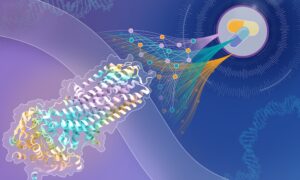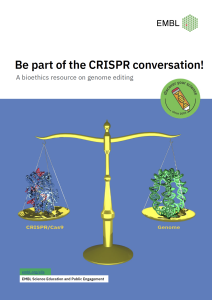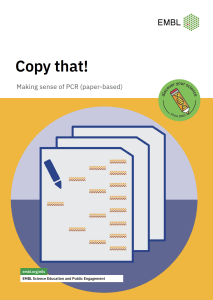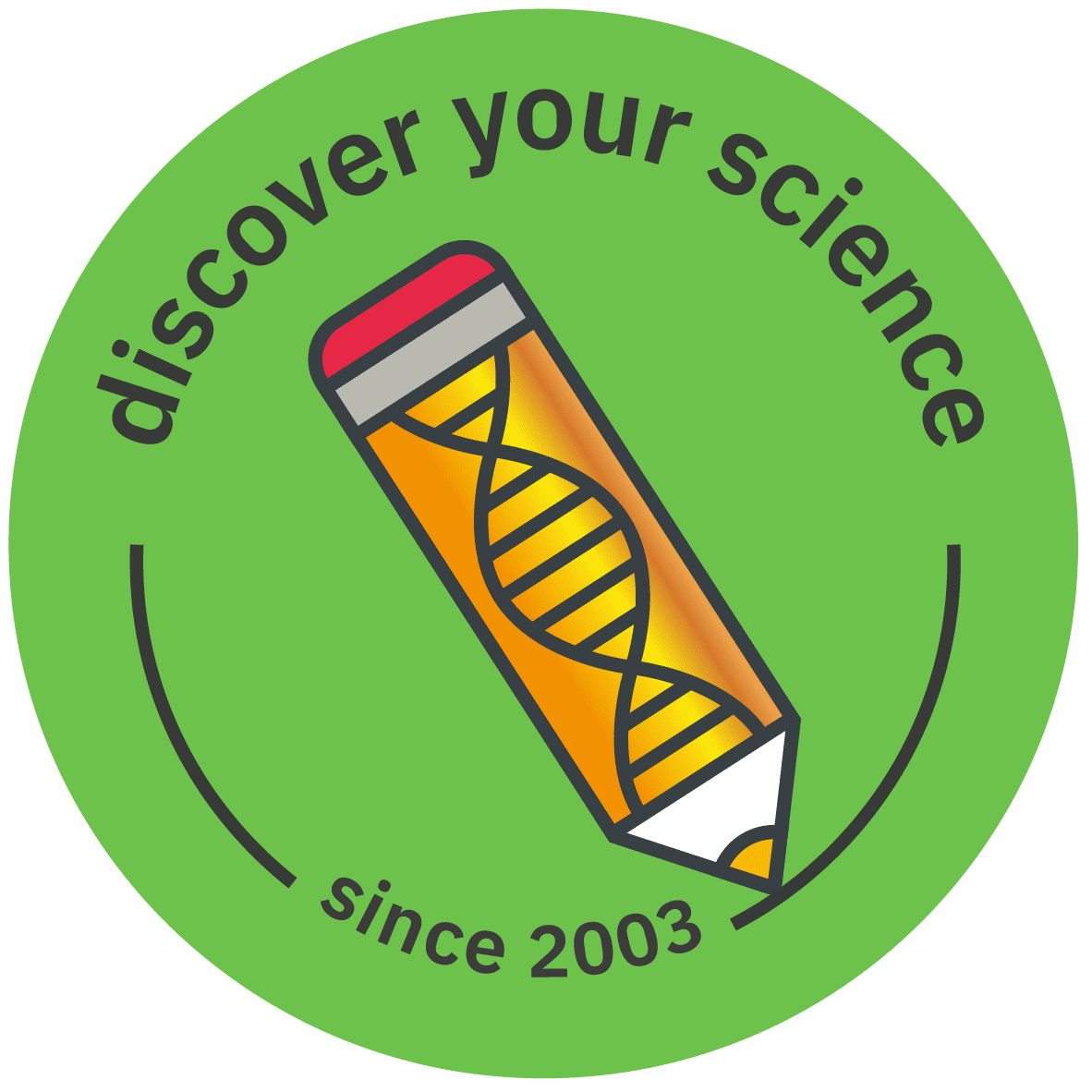
Part 3: Multiple sequence alignment
Overview
Well done! In Part 2 we discovered that our unknown protein is most likely rhodopsin – the photosensitive protein of the retina. Rhodopsins belong to a class of proteins called opsins, which typically bind a chromophore called retinal.
Now we want to learn more about rhodopsins and utilise bioinformatics to explore their evolutionary changes. This will help us understand the evolution of our new species and identify any closely related species. We do this by performing a so-called multiple sequence alignment, a technique that involves aligning numerous rhodopsin amino acid sequences from various species. The alignment ensures, if possible, that similar residues are consistently positioned beneath each other. If this is the case for a big proportion of the amino acids, it would mean that the sequences are closely related.
You can find a set of prepared sequences in the tab “Sequences”. The first sequence (“>New species (Unknown)”) corresponds to the rhodopsin you previously used. The other sequences correspond to rhodopsins from 20 different organisms, including human and common research organisms like fruit flies, house mice, rats and zebrafishes.
Your task
Please follow the steps outlined below:
1. Using the sequences available in the “Sequences” tab, align the rhodopsins from 21 different species for comparison using the EMBL-EBI Clustal Omega multiple sequences alignment tool.
2. Follow the instructions in the “Clustal Omega” tab.
3. Try to answer the questions in the “Questions” tab.
Sequences
>New species (Unknown)
MNGTEGPFGYIPMSNATGLVRSPYDYPQYYLVPPWGYACLAAYMFLLILTGFPVNFLTLY
VTIEHKKLRSPLNYILLNLAVADLFMVIGGFTTTMWTSLBGYFVFGRMGCNIEGFFATLG
GEIALWSLVVLSMERWIVVCKPISNFRFGENHAVMGVAFSWFMAAACAVPPLVGWSRYIP
EGMQCSCGIDYYTRAEGFNNESFVIYMFVVFFTCPLTIITFCYGRLVCTVKEAAAQQQES
ETTQRAEREVTRMVIITFVAFLACWVPYASVAWYIFTHQGSEFGPVFMTIPAFFAKSSAV
YNPVIYICLNKQFRHCMITTLCCGKNPFEEEEGSTTASKTEASSVCSVSPHA
>Drosophila melanogaster (Fruit fly)
MASLHPPSFAYMRDGRNLSLAESVPAEIMHMVDPYWYQWPPLEPMWFGIIGFVIAILGTM
SLAGNFIVMYIFTSSKGLRTPSNMFVVNLAFSDFMMMFTMFPPVVLNGFYGTWIMGPFLC
ELYGMFGSLFGCVSIWSMTLIAYDRYCVIVKGMARKPLTATAAVLRLMVVWTICGAWALM
PLFGWNRYVPEGNMTACGTDYFAKDWWNRSYIIVYSLWVYLTPLLTIIFSYWHIMKAVAA
HEKAMREQAKKMNVASLRNSEADKSKAIEIKLAKVALTTISLWFFAWTPYTIINYAGIFE
SMHLSPLSTICGSVFAKANAVCNPIVYGLSHPKYKQVLREKMPCLACGKDDLTSDSRTQA
TAEISESQA
>Sus scrofa (Wild boar)
MNGTEGPNFYVPFSNKTGVVRSPFEYPQYYLAEPWQFSMLAAYMFMLIVLGFPINFLTLY
VTVQHKKLRTPLNYILLNLAVADLFMVFGGFTTTLYTSLHGYFVFGPTGCNLEGFFATLG
GEIALWSLVVLAIERYVVVCKPMSNFRFGENHAIMGLALTWVMALACAAPPLVGWSRYIP
EGLQCSCGIDYYTLKPEVNNESFVIYMFVVHFSIPLVIIFFCYGQLVFTVKEAAAQQQES
ATTQKAEKEVTRMVIIMVVAFLICWLPYASVAFYIFTHQGSDFGPIFMTIPAFFAKSASI
YNPVIYIMMNKQFRNCMLTTLCCGKNPLGDDEASTTTSKTETSQVAPA
>Bos taurus (Cattle)
MNGTEGPNFYVPFSNKTGVVRSPFEAPQYYLAEPWQFSMLAAYMFLLIMLGFPINFLTLY
VTVQHKKLRTPLNYILLNLAVADLFMVFGGFTTTLYTSLHGYFVFGPTGCNLEGFFATLG
GEIALWSLVVLAIERYVVVCKPMSNFRFGENHAIMGVAFTWVMALACAAPPLVGWSRYIP
EGMQCSCGIDYYTPHEETNNESFVIYMFVVHFIIPLIVIFFCYGQLVFTVKEAAAQQQES
ATTQKAEKEVTRMVIIMVIAFLICWLPYAGVAFYIFTHQGSDFGPIFMTIPAFFAKTSAV
YNPVIYIMMNKQFRNCMVTTLCCGKNPLGDDEASTTVSKTETSQVAPA
>Homo sapiens (Human)
MNGTEGPNFYVPFSNATGVVRSPFEYPQYYLAEPWQFSMLAAYMFLLIVLGFPINFLTLY
VTVQHKKLRTPLNYILLNLAVADLFMVLGGFTSTLYTSLHGYFVFGPTGCNLEGFFATLG
GEIALWSLVVLAIERYVVVCKPMSNFRFGENHAIMGVAFTWVMALACAAPPLAGWSRYIP
EGLQCSCGIDYYTLKPEVNNESFVIYMFVVHFTIPMIIIFFCYGQLVFTVKEAAAQQQES
ATTQKAEKEVTRMVIIMVIAFLICWVPYASVAFYIFTHQGSNFGPIFMTIPAFFAKSAAI
YNPVIYIMMNKQFRNCMLTTICCGKNPLGDDEASATVSKTETSQVAPA
>Mus musculus (House mouse)
MNGTEGPNFYVPFSNVTGVVRSPFEQPQYYLAEPWQFSMLAAYMFLLIVLGFPINFLTLY
VTVQHKKLRTPLNYILLNLAVADLFMVFGGFTTTLYTSLHGYFVFGPTGCNLEGFFATLG
GEIALWSLVVLAIERYVVVCKPMSNFRFGENHAIMGVVFTWIMALACAAPPLVGWSRYIP
EGMQCSCGIDYYTLKPEVNNESFVIYMFVVHFTIPMIVIFFCYGQLVFTVKEAAAQQQES
ATTQKAEKEVTRMVIIMVIFFLICWLPYASVAFYIFTHQGSNFGPIFMTLPAFFAKSSSI
YNPVIYIMLNKQFRNCMLTTLCCGKNPLGDDDASATASKTETSQVAPA
>Gallus gallus (Red junglefowl)
MNGTEGQDFYVPMSNKTGVVRSPFEYPQYYLAEPWKFSALAAYMFMLILLGFPVNFLTLY
VTIQHKKLRTPLNYILLNLVVADLFMVFGGFTTTMYTSMNGYFVFGVTGCYIEGFFATLG
GEIALWSLVVLAVERYVVVCKPMSNFRFGENHAIMGVAFSWIMAMACAAPPLFGWSRYIP
EGMQCSCGIDYYTLKPEINNESFVIYMFVVHFMIPLAVIFFCYGNLVCTVKEAAAQQQES
ATTQKAEKEVTRMVIIMVIAFLICWVPYASVAFYIFTNQGSDFGPIFMTIPAFFAKSSAI
YNPVIYIVMNKQFRNCMITTLCCGKNPLGDEDTSAGKTETSSVSTSQVSPA
>Cricetulus griseus (Chinese Hamster)
MNGTEGPNFYVPFSNATGVVRSPFEYPQYYLAEPWQFSMLAAYMFLLIVLGFPINFLTLY
VTVQHKKLRTPLNYILLNLAVADLFMVFGGFTTTLYTSLHGYFVFGPTGCNLEGFFATLG
GEIALWSLVVLAIERYVVICKPMSNFRFGENHAIMGVVFTWIMALACAAPPLVGWSRYIP
EGMQCSCGVDYYTLKPEVNNESFVIYMFVVHFTIPLIVIFFCYGQLVFTVKEAAAQQQES
ATTQKAEKEVTRMVILMVVFFLICWFPYAGVAFYIFTHQGSNFGPIFMTLPAFFAKSSSI
YNPVIYIMMNKQFRNCMLTTLCCGKNILGDDEASATASKTETSQVAPA
>Canis lupus familiaris (Dog)
MNGTEGPNFYVPFSNKTGVVRSPFEYPQYYLAEPWQFSMLAAYMFLLIVLGFPINFLTLY
VTVQHKKLRTPLNYILLNLAVADLFMVFGGFTTTLYTSLHGYFVFGPTGCNVEGFFATLG
GEIALWSLVVLAIERYVVVCKPMSNFRFGENHAIMGVAFTWVMALACAAPPLAGWSRYIP
EGMQCSCGIDYYTLKPEINNESFVIYMFVVHFAIPMIVIFFCYGQLVFTVKEAAAQQQES
ATTQKAEKEVTRMVIIMVIAFLICWVPYASVAFYIFTHQGSDFGPIFMTLPAFFAKSSSI
YNPVIYIMMNKQFRNCMITTLCCGKNPLGDDEASASASKTETSQVAPA
>Danio rerio (Zebrafish)
MNGTEGPAFYVPMSNATGVVRSPYEYPQYYLVAPWAYGLLAAYMFFLIITGFPVNFLTLY
VTIEHKKLRTPLNYILLNLAIADLFMVFGGFTTTMYTSLHGYFVFGRLGCNLEGFFATLG
GEMGLWSLVVLAIERWMVVCKPVSNFRFGENHAIMGVAFTWVMACSCAVPPLVGWSRYIP
EGMQCSCGVDYYTRTPGVNNESFVIYMFIVHFFIPLIVIFFCYGRLVCTVKEAAAQQQES
ETTQRAEREVTRMVIIMVIAFLICWLPYAGVAWYIFTHQGSEFGPVFMTLPAFFAKTSAV
YNPCIYICMNKQFRHCMITTLCCGKNPFEEEEGASTTASKTEASSVSSSSVSPA
>Rattus norvegicus (Brown rat)
MNGTEGPNFYVPFSNITGVVRSPFEQPQYYLAEPWQFSMLAAYMFLLIVLGFPINFLTLY
VTVQHKKLRTPLNYILLNLAVADLFMVFGGFTTTLYTSLHGYFVFGPTGCNLEGFFATLG
GEIGLWSLVVLAIERYVVVCKPMSNFRFGENHAIMGVAFTWVMALACAAPPLVGWSRYIP
EGMQCSCGIDYYTLKPEVNNESFVIYMFVVHFTIPMIVIFFCYGQLVFTVKEAAAQQQES
ATTQKAEKEVTRMVIIMVIFFLICWLPYASVAMYIFTHQGSNFGPIFMTLPAFFAKTASI
YNPIIYIMMNKQFRNCMLTSLCCGKNPLGDDEASATASKTETSQVAPA
>Delphinus delphis (Short-beaked common dolphin)
MNGTEGLNFYVPFSNKTGVVRSPFEYPQYYLAEPWQFSVLAAYMFLLIVLGFPINFLTLY
VTVQHKKLRTPLNYILLNLAVANLFMVFGGFTTTLYTSLHAYFVFGPTGCNLEGFFATLG
GEIALWSLVVLAIERYVVVCKPMSNFRFGENHAIMGLALTWIMAMACAAPPLVGWSRYIP
EGMQCSCGIDYYTLSPEVNNESFVIYMFVVHFTIPLVIIFFCYGQLVFTVKEAAAQQQES
ATTQKAEKEVTRMVIIMVVAFLICWVPYASVAFYIFTHQGSDFGPIFMTIPSFFAKSSSI
YNPVIYIMMNKQFRNCMLTTLCCGRNPLGDDEASTTASKTETSQVAPA
>Mesoplodon bidens (Sowerby's beaked whale)
MNGTEGLNFYVPFSNHTGVVRSPFEYPQYYLAEPWQFSVLAAYMFLLIMLGFPINFLTLY
VTVQHKKLRTPLNYILLNLAVANLFMVLGGFTTTLYTSMHAYFIFGPTGCNLEGFFATLG
GEIALWSLVVLAIERYVVVCKPMSNFRFGENHAIMGLALTWIMALACAAPPLVGWSRYIP
EGMQCSCGVDYYTPSPEVNNESFVVYMFVVHFSIPMVIIFFCYGQLVFTVKEAAAQQQES
ATTQKAEKEVTRMVVIMVVAFLICWVPYASVAFYIFTHQGSNFGPIFMTIPSFFAKSSAI
YNPVIYIMMNKQFRNCMLTTLCCGRNPLGDDEVSTTASKTETSQVAPA
>Phoca vitulina (Harbor seal)
MNGTEGPNFYVPFSNKTGVVRSPFEFPQYYLAEPWQFSMLAAYMFLLIVLGFPINFLTLY
VTVQHKKLRTPLNYILLNLAVADLFMVFGGFTTTLYTSLHGYFVFGPTGCNLEGFFATLG
GEIALWSLVVLAIERYVVVCKPMSNFRFGENHAIMGVGFTWVMALACAAPPLVGWSRYIP
EGMQCSCGIDYYTLKPEVNNESFVIYMFVVHFTIPMIVIFFCYGQLVFTVKEAAAQQQES
ATTQKAEKEVTRMVIIMVIAFLICWVPYASVAFYIFTHQGSNFGPIFMTLPAFFAKAASI
YNPVIYIMMNKQFRTCMITTLCCGKNPLGDDEVSASASKTETSQVAPA
>Scyliorhinus canicula (Catshark)
MNGTEGENFYIPMSNKTGVVRSPFDYPQYYLAEPWKFSVLAAYMFFLIIAGFPVNFLTLY
VTIQHKKLRQPLNYILLNLAVADLFMIFGGFPSTMITSMNGYFVFGPSGCNFEGFFATLG
GEIGLWSLVVLAIERYVVVCKPMSNFRFGSQHAFMGVGLTWIMAMACAFPPLVGWSRYIP
EGMQCSCGIDYYTLKPEVNNESFVIYMFVVHFSIPLTIIFFCYGRLVCTVKEAAAQQQES
ETTQRAEREVTRMVIIMVIAFLICWLPYASVAFFIFCNQGSEFGPIFMTIPAFFAKAASL
YNPLIYILMNKQFRNCMITTICCGKNPFEEEESTSASASKTEASSVSSSQVAPA
>Carassius auratus (Goldfish)
MNGTEGDMFYVPMSNATGIVRSPYDYPQYYLVAPWAYACLAAYMFFLIITGFPVNFLTLY
VTIEHKKLRTPLNYILLNLAISDLFMVFGGFTTTMYTSLHGYFVFGRVGCNPEGFFATLG
GEMGLWSLVVLAFERWMVVCKPVSNFRFGENHAIMGVVFTWFMACTCAVPPLVGWSRYIP
EGMQCSCGVDYYTRPQAYNNESFVIYMFIVHFIIPLIVIFFCYGRLVCTVKEAAAQHEES
ETTQRAEREVTRMVVIMVIGFLICWIPYASVAWYIFTHQGSEFGPVFMTLPAFFAKTAAV
YNPCIYICMNKQFRHCMITTLCCGKNPFEEEEGASTTASKTEASSVSSSSVSPA
>Lithobates catesbeianus (American bullfrog)
MNGTEGPNFYVPMSNKTGIVRSPFEYPQYYLAEPWKYSVLAAYMFLLILLGLPINFMTLY
VTIQHKKLRTPLNYILLNLAFANHFMVLCGFTITMYTSLHGYFVFGQTGCYFEGFFATLG
GEIALWSLVVLAIERYIVVCKPMSNFRFGENHAMMGVAFTWIMALACAVPPLFGWSRYIP
EGMQCSCGVDYYTLKPEVNNESFVIYMFVVHFLIPLIIISFCYGRLVCTVKEAAAQQQES
ATTQKAEKEVTRMVVIMVIFFLICWVPYAYVAFYIFTHQGSEFGPIFMTVPAFFAKSSAI
YNPVIYIMLNKQFRNCMITTLCCGKNPFGDEDASSAATSKTEATSVSTSQVSPA
>Bufo bufo (Common toad)
MNGTEGPNFYIPMSNKTGVVRSPFEYPQYYLAEPWQYSILCAYMFLLILLGFPINFMTLY
VTIQHKKLRTPLNYILLNLAFANHFMVLCGFTVTMYSSMNGYFILGATGCYVEGFFATLG
GEIALWSLVVLAIERYVVVCKPMSNFRFSENHAVMGVAFTWIMALSCAVPPLLGWSRYIP
EGMQCSCGVDYYTLKPEVNNESFVIYMFVVHFTIPLIIIFFCYGRLVCTVKEAAAQQQES
ATTQKAEKEVTRMVIIMVVFFLICWVPYASVAFFIFSNQGSEFGPIFMTVPAFFAKSSSI
YNPVIYIMLNKQFRNCMITTLCCGKNPFGEDDASSAATSKTEASSVSSSQVSPA
>Oryzias latipes (Japanese rice fish)
MNGTEGPYFNVPMVNTTGIVRSPYEYPQYYLVSPAAYAALGAYMFFLILVGFPINFLTLY
VTLEHKKLRTPLNYILLNLAVADLFMVFGGFTTTMYTSMHGYFVLGRLGCNLEGFFATLG
GEIGLWSLVVLAIERWVVVCKPISNFRFGENHAIMGLVFTWIMAASCAVPPLVGWSRYIP
EGMQCSCGVDYYTRAEGFNNESFVVYMFVCHFLIPLIVVFFCYGRLLCAVKEAAAAQQES
ETTQRAEREVTRMVVIMVIGFLVCWLPYASVAWYIFTNQGSEFGPLFMTIPAFFAKSSSI
YNPAIYICMNKQFRNCMITTLCCGKNPFEEEEGASTTASKTEASSVSSSSVSPA
>Sardina pilchardus (Pilchard)
MNGTEGPFFYIPMSNATGLVRSPYDYPQYYLVPPWGYACLAAYMFLLILTGFPVNFLTLY
VTIEHKKLRSPLNYILLNLAVADLFMVIGGFTTTMWTSLNGYFVFGRMGCNIEGFFATLG
GEIALWSLVVLSMERWIVVCKPISNFRFGENHAVMGVAFSWFMAAACAVPPLVGWSRYIP
EGMQCSCGIDYYTRAEGFNNESFVIYMFVVHFTCPLTIITFCYGRLVCTVKEAAAQQQES
ETTQRAEREVTRMVIIMFVAFLACWVPYASVAWYIFTHQGSEFGPVFMTIPAFFAKSSAV
YNPVIYICLNKQFRHCMITTLCCGKNPFEEEEGSTTASKTEASSVCSVSPA
>Lacunicambarus ludovicianus (Painted devil crayfish)
LHMIHLHWYQYPPMNPMMYPLLLVFMLITGILCLAGNFVTIWVFMNTKSLRTPANLLVVN
LAMSDFLMMFTMFPPMMITCYYHTWTLGATFCEVYAFLGNLCGCASIWTMVFITFDRYNV
IVKGVAGEPLSTKKASLWILTVWVLSFTWCVAPFFGWNRYVPEGNLTGCGTDYLSEDILS
RSYLYIYSTWVYFLPLAITIYCYVFIIKAVAAHEKGMRDQAKKMGIKSLRNEEAQKTSAE
CRLAKIAMTTVALWFIAWTPYLLINWVGMFARSYLSPVYTIWGYVFAKANAVYNPIVYAI
SClustal Omega
1. Paste all the amino acid sequences, including greater-than symbols and species names, into the input box in the window below. (Alternatively, upload this FASTA file containing the sequences from your computer.)
2. Select “ClustalW with character counts” as the output format.
3. Submit the sequences for alignment.
4. The multiple rhodopsin sequences have now been aligned. You can view the results in the “Alignment” tab and for a better visualisation, click on “Show Colors”.
5. Download or copy the aligned amino acid sequences for the next task (including “CLUSTAL O(1.2.4) multiple sequence alignment”).
Note: The output of multiple sequence alignments also contains an additional line underneath the last sequence that gives information about how conserved a specific residue is. Here’s how to interpret this:
– Asterisk (*): fully conserved residue (identical in all sequences)
– Colon (:): strongly conserved residue
– Period (.): semi-conserved residue
– Empty ( ): non-conserved residue
Questions
1. What can you deduce from the alignment? Are there any notable differences in the length of the sequences?
2. Which species possesses the longest rhodopsin amino acid sequence?
3. Are there any conserved residues or parts of the sequences present in all the species? Are there some parts that are found solely in one or a few species?
Activity navigation

Share:
 Deutsch
Deutsch


